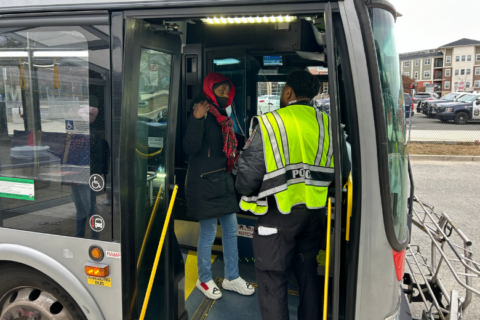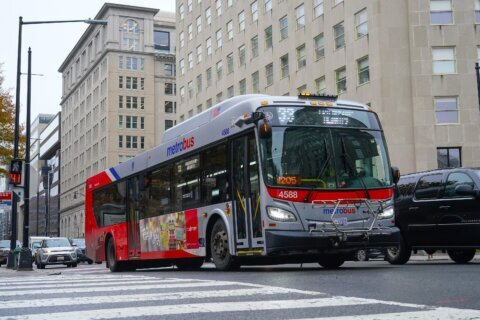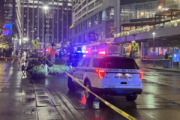Metrorail has begun the process of considering changes to how fares are charged and collected, as a growing post-pandemic ridership is using the system in different ways.
Nothing has been proposed yet, much less endorsed, but the transit system’s leaders have hinted that some popular concepts discussed online by riders may not be as simple and feasible as they think.
Tom Webster, Metro’s vice president of strategy, planning and program management, described ridership at a Metro board meeting last week.
“A smaller share of customers are riding the rail system at peak hours, and those rail trips tend to be shorter than pre-pandemic,” Webster said.
He indicated how many of Metro’s riders go “to or through the center part of the system,” regardless of where they’re headed.
Thirty-four of the system’s 98 stations are within 3 miles of the system’s center, Webster said, and about 60% of station entries and exits and 18 of the top 20 ridership stations are within that radius. So are about 75% of the weekday exits before 10 a.m. and weekday entries after 7 p.m., he said.
Board Chair Paul Smedberg said that “everything is still on the table,” and Webster’s presentation made clear that a really, really big table is needed.
Some plans would be easier than others, such as a simple fare hike across the board. So what are they?
Zone-based fares
Webster said a zone-based fare structure could include boundaries drawn by jurisdiction, distance from Metro’s core, or even by certain types of stations.
The number of zones, and how to charge each of those zones, can also vary. During his presentation last week, Webster showed what maps with three, four, and five zones could look like.
“More zones allow for smaller price jumps between zones,” said Webster.
Showing off a potential five-zoned fare system, he showed a Red Line trip from Tenleytown to Union Station would cross one boundary, leading to a 20% lower price compared to what it is today. A trip from College Park, Maryland, to Columbia Heights, conversely, would cross three zones and cost 30% more than it does now — as would a train from Franconia to the Pentagon on the Blue Line, which would cross four boundaries.
“At a conceptual level, zoned fares might offer a number of opportunities for improvement,” Webster added. “But it can also result in long trips in one zone costing less than short trips between zones, as well as loss of price-sensitive customers who see a fare increase for those short trips.”
He also cautioned the board that implementing zones would be among the more complicated options, and that communicating those changes would also be harder.
“D.C. had a zone concept for our taxicab system and it was one of the most confusing things, especially for our tourists,” said board member Lucinda Babers. “We eventually got rid of it, of course, and went to a distance-based concept.”
Flat fares
How would a single fare for everyone work? On the surface it sounds simpler, but Webster said it’s also less fair and might not generate the money Metro needs.
“Transition from a distance-based fare structure to a flat fare, at any price level, poses some considerable equity considerations and potential Title VI issues,” said Webster. “A higher flat fare would increase fares for a very large number of riders, most likely disproportionately low-income, minority riders. A lower flat fare would decrease fares for riders that are proportionately higher income and less minority as a percentage.”
Metro General Manager Randy Clarke said much the same thing.
“It is the most inequitable aspect to go to a flat fare,” Clarke said. “It might seem simple, and a lot of people who probably live just in the District might go ‘Oh, that makes sense’ if they’re going two stops, but then someone further out might be getting an actual benefit that actually is inequitable to the people that are more low-income.”
Clarke said many people like the idea of carrying flat fares over from the New York subway system, but “We’re not New York City subway. We’re a combination of New York City subway and Long Island Railroad and Metro North railroad. We’re a hybrid system; we are a commuter rail and a subway system combined and that is a big difference.”
He agreed with Webster that making a switch to a flat fare would bring “significant” Title VI equity concerns from the federal Department of Transportation.
Improving distance-based fares
Webster said there are several ways to make the current system easier and better, such as basing distance on a straight line from point A to point B, or eliminating the distinction between peak and off-peak fares. You could also round fares to the nearest quarter, or just have a single mileage rate.
“We could customize fare maps at each station that show fares to every other station,” said Webster. “We could potentially put easier-to-use fare calculators on the web and eventually on future ticket vending machines,” too.
There was also discussion about what a cost-per-mile fare would look like.
At this point nothing is imminent, and some concepts are more long-term projects that will take longer to implement than others depending on how and if Metro decides to move forward.
“It is going to be a dramatic change for the region,” said Smedberg. “We have to carefully look at the financial piece.”
Board member Tracy Hadden Loh said, “There’s a lot of things in that presentation that a lot of us like,” and was enthusiastic about moving forward on adopting changes as soon as the next fiscal year, considering Metro is looking at a significant budget shortfall in fiscal 2024.







